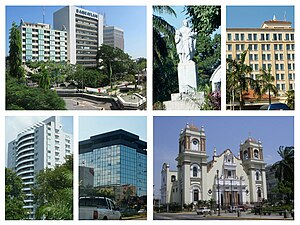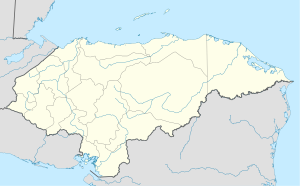San Pedro Sula
San Pedro Sula is a city in Honduras. With 873,824 people in the main municipality, and 1,245,598 in its metro area (2010), it is the second largest city, after the capital Tegucigalpa. It is considered the industrial center[3] of Honduras. It is the capital of the Cortés Department.
San Pedro Sula
"Usula (Valley of Birds)" | |
|---|---|
 San Pedro Sula | |
| Nickname(s): La Capital Industrial | |
| Coordinates: 15°30′0″N 88°2′0″W / 15.50000°N 88.03333°W | |
| Country | |
| Department | Cortés |
| Municipio (County) | San Pedro Sula |
| Foundation | June 1536 |
| Government | |
| • Mayor | Roberto Contreras (Libre) |
| Area | |
| • Urban | 840 km2 (320 sq mi) |
| Elevation | 83 m (272 ft) |
| Population | |
| • City | 873,824 |
| • Density | 2,427.7/km2 (6,288/sq mi) |
| • Metro | 1,245,598 |
| Time zone | UTCUTC(−6GMT) |
| Climate | Aw |
History
changeBefore the arrival of the Spanish, the Sula Valley was home to approximately 50,000 native inhabitants.[4] The area that is home to the modern city served as a local trade hub for the Mayan and Aztec civilizations. The Spanish conquest brought about a demographic collapse from which the native population would never recover.
On 27 June 1536, Don Pedro de Alvarado founded a Spanish town beside the Indian settlement of Choloma, with the name of Villa de Señor San Pedro de Puerto Caballos (modern San Pedro Sula). The new town had 35 Spanish citizens, and Alvarado allocated 200 of his slaves to help build the new town and work the surrounding fields. He sent out expeditions into outlying regions to secure the new town, extend the area of Spanish domination, and commandeer supplies. Alvarado annulled all encomienda rights established in the area under Andres de Cerezeda, and reassigned the villages to the citizens of San Pedro.
The new settlement barely survived the colonial period. In 1601, the Spanish government declared Santo Tomás as the official port for the Central American colonies; this move diverted exports from Puerto Cortés and resulted in an economic decline that would last through the 17th century. Additionally, San Pedro Sula was left exposed to raids by pirates and French, Dutch, and English mercenaries. By the mid-18th century, the Spanish government decided to build a number of coastal fortresses to curb English attacks. One of these fortresses, the Fortaleza de San Fernando, was built in Omoa, less than 50 miles from San Pedro Sula. The subsequent increase in trade supported an increase in population from 70 inhabitants in 1714 to 357 in 1789.[5]
Post-independence San Pedro Sula remained an impoverished village, dependent on trade between Omoa and the country's interior. In 1875, Frank Frye, the American consul in the Bay Islands, reported a population of 1200. The city benefitted from the growth of the banana trade in the 1870s and 1880s and formed a close relationship with US-based shipper and railroad entrepreneur Samuel Zemurray's Cuyamel Fruit Company, and the construction of the Interoceanic Railroad between 1869 and 1874 which connected the city to the coast at Puerto Cortés. Zemurray worked closely with local elites who invested in subsidiary enterprises and thus shaped the way politically for Cuyamel to establish itself and pay very few taxes.[6]
Climate
changeSan Pedro Sula features has a tropical savanna climate (Aw) under the Koppen Climate Classification, tending a tropical monsoon climate (Am) slight influences ;with a dry season spanning from April through May and a wet season covering the remaining ten months. The city experiences relatively high temperatures year-round and some rainfall. San Pedro Sula has experienced hurricanes and tropical storms and is prone to them during the hurricane season usually when the storms form in the southern part of the Caribbean or Western Africa.
| Climate data for San Pedro Sula, Honduras (La Mesa International Airport) 1961–1990, extremes 1944–present | |||||||||||||
|---|---|---|---|---|---|---|---|---|---|---|---|---|---|
| Month | Jan | Feb | Mar | Apr | May | Jun | Jul | Aug | Sep | Oct | Nov | Dec | Year |
| Record high °C (°F) | 35.0 (95.0) |
37.0 (98.6) |
41.0 (105.8) |
43.0 (109.4) |
42.0 (107.6) |
40.0 (104.0) |
38.0 (100.4) |
38.8 (101.8) |
37.2 (99.0) |
37.0 (98.6) |
36.0 (96.8) |
35.0 (95.0) |
39.5 (103.1) |
| Average high °C (°F) | 30.2 (86.4) |
30.9 (87.6) |
33.0 (91.4) |
34.0 (93.2) |
35.2 (95.4) |
34.3 (93.7) |
33.3 (91.9) |
33.4 (92.1) |
33.5 (92.3) |
31.6 (88.9) |
30.2 (86.4) |
29.9 (85.8) |
32.3 (90.1) |
| Daily mean °C (°F) | 23.5 (74.3) |
24.1 (75.4) |
25.8 (78.4) |
27.1 (80.8) |
28.1 (82.6) |
27.7 (81.9) |
27.1 (80.8) |
27.3 (81.1) |
27.2 (81.0) |
25.0 (77.0) |
24.7 (76.5) |
23.5 (74.3) |
24.9 (76.8) |
| Average low °C (°F) | 19.9 (67.8) |
20.0 (68.0) |
21.4 (70.5) |
24.3 (75.7) |
24.8 (76.6) |
24.8 (76.6) |
24.3 (75.7) |
24.3 (75.7) |
24.3 (75.7) |
24.3 (75.7) |
21.0 (69.8) |
20.0 (68.0) |
22.8 (73.0) |
| Record low °C (°F) | 10.8 (51.4) |
10.0 (50.0) |
13.4 (56.1) |
15.0 (59.0) |
17.2 (63.0) |
17.0 (62.6) |
18.9 (66.0) |
18.9 (66.0) |
18.9 (66.0) |
13.9 (57.0) |
13.1 (55.6) |
12.5 (54.5) |
10.0 (50.0) |
| Average precipitation mm (inches) | 49.0 (1.93) |
20.6 (0.81) |
9.0 (0.35) |
5.3 (0.21) |
42.0 (1.65) |
162.4 (6.39) |
240.2 (9.46) |
115.7 (4.56) |
118.7 (4.67) |
100.8 (3.97) |
470.3 (18.52) |
69.7 (2.74) |
1,403.7 (55.26) |
| Average precipitation days (≥ 1.0 mm) | 7 | 6 | 1 | 1 | 6 | 10 | 16 | 17 | 12 | 10 | 10 | 9 | 89 |
| Average relative humidity (%) | 77 | 81 | 85 | 85 | 86 | 86 | 89 | 89 | 89 | 88 | 83 | 67 | 84 |
| Mean monthly sunshine hours | 186.0 | 178.0 | 238.7 | 222.0 | 220.1 | 201.0 | 210.8 | 198.4 | 183.0 | 198.4 | 156.0 | 155.0 | 2,347.4 |
| Mean daily sunshine hours | 6.0 | 6.3 | 7.7 | 7.4 | 7.1 | 6.7 | 6.8 | 6.4 | 6.1 | 6.4 | 5.2 | 5.0 | 6.4 |
| Source 1: NOAA[7] | |||||||||||||
| Source 2: Deutscher Wetterdienst (sun and humidity),[8] Meteo Climat (record highs and lows)[9] | |||||||||||||
Administrative divisions
changeSan Pedro Sula, as most cities built under the Spanish colonial period,[source?] is divided in quadrants. Avenues in the city run from north to south and streets run from east to west. First Street and First Avenue mark the "center of the city" and effectively divide it into four major quadrants NW, NE, SW and SE.[10] Barrio El Benque, the business district, is just to the west and south of the center, and other neighborhoods in the suroeste include Barrio Paz Barahona, Barrio La Guardia, Colonia Altamira, Colonia Mesetas, Barrio Río de Piedras, Barrio Suyapa (from 12 Avenida S out to Avenida Circunvalación, from 7 Calle S to 10 Calles S), Colonia Hernandez, Barrio Prado Alto, and Colonia El Chamelecón. The latter includes area from 23 Avenida S west to 27 Avenida S, from 1 Calle (named Bulevar Los Próceres there) south to 5 Calle S0. To the south of Colonia El Chamelecón are Colonia Dubón, Colonia Figueroa, Colonia Trejo (from 10 Calle S to 12 Calle S, from about Avenida Circunvalación to 25 Avenida S, including the Consulate of Nicaragua), Colonia Altamira, and Colonia Altiplano. Colonia Las Mesetas runs from 12 Calle S to 14 Calle S, from 21 Avenida A (S) to past 24 Avenida S.[11]
Barrio Guamilito is just to the west and north of the center. Noroeste neighborhoods include Colonia Moderna (from 1 Calle to 5 Calle NO, from Avendia Circunvalación to the river beyond 24 Avenida), Colonia La Mora (from 5 Calle NO to 7 Calle NO, from Avendia Circunvalación to the río beyond 24 Avenida), Colonia Zeron, the Colonia Columbia by the Universidad de San Pedro Sula, Barrio La Cervecería and Barrio Guadalupe. Across the river along which 24 Avenida runs is Colonia Juan Lindo and Colonia Jardines Del Valle.[11]
From the river past 24 Avenida, north to 25 Calle and west to 12 Avenida, is Colonia Universidad. Universidad de San Pedro Sula is to its south, across the river. West of Colonia Universidad is Colonia Country, a small neighborhood including the Academia Americana, and Colonia Villas del Sol, which runs from Boulevard Mackey west to include Universidad Nacional Autonoma de Honduras en el Valle de Sula, and goes north to Río Bermejo but does not cross it.[11]
Just past the Universidad Nacional Autónoma de Honduras en el Valle de Sula, and spanning the Río Bermejo, is Colonia El Pedregal, which has residential high-rises.[11]
Further out, north across the Río Bermejo, running to the edge of the city, and with calles (streets) renumbering from 1 up, are Colonia Los Alpes and Rancho El Coco and Residencial Los Cedros and Colonia La Tara.[11]
Far to the north is Colonia Fesitranh.[11] Barrio Las Acacias is just to the north of center. Nor-Este neighborhoods include Barrio San Cristobal, Villa Florencia, Colonia Ideal, Barrio Morazán, Colonia Modelo, and further out Colonia Bográn, Colonia El Carmen, and Colonia Los Laureles.[11] Includes the road to the airport, Aeropuerto Internacional Ramon Villeda Morales and to the city of La Lima. Southeast neighborhoods include Barrio Medina (11 Calle SE to Avenida Juan Pablo II, 4 Avenida SO to 10 Avenida SE), Colonia La Aurora (defined by 7 Calle SE to 10 Calle SE, and 14 Avenida SE to Segundo Anilo, approximately where 18 Avenida would be), Barrio Cabañas, Barrio La Navidad, San Pedro, Barrio Las Palmas, Barrio San Luís, Colonia La Unión, Barrio La Paz. Farther out: Colonia Rivera Hernández, San Cristobal.[11]
References
change- ↑ "Honduras: largest cities and towns and statistics of their population". World Gazeteer. Retrieved 22 May 2010.[permanent dead link]
- ↑ "Honduras: metropolitan areas". World Gazeteer. Retrieved 24 February 2010.[permanent dead link]
- ↑ "San Pedro Sula becomes popular convention destination". Archived from the original on 2001-08-23. Retrieved 2013-03-05.
- ↑ Euraque, Darío. El capitalismo de San Pedro Sula y la historia política hondureña (1870–1972). Editorial Guaymuras, 2001.
- ↑ The Cost of Conquest: Indian Decline in Honduras Under Spanish Rule. By Newson, Linda. Boulder: Westview Press, 1986. Pp. 375. Paper.
- ↑ Dario Euraque, Reinterperting the Banana Republic: Region and State in Honduras, 1870–1972 (Chapel Hill, North Carolina: University of North Carolina Press, 1996) pp. 25–27.
- ↑ "La Mesa Climate Normals 1961–1990". National Oceanic and Atmospheric Administration. Retrieved 24 January 2016.
- ↑ "Klimatafel von San Pedro Sula (La Mesa) , Bez.Cortés / Honduras" (PDF). Baseline climate means (1961–1990) from stations all over the world (in German). Deutscher Wetterdienst. Retrieved 24 January 2016.
- ↑ "Station La Mesa" (in French). Meteo Climat. Retrieved 12 June 2016.
- ↑ Fiallos, Maria (2 January 2009). Honduras and the Bay Islands Adventure Guide. Edison, NJ: Hunter Publishing, Inc. ISBN 978-1-58843-602-3. Retrieved 1 July 2012.
- ↑ 11.0 11.1 11.2 11.3 11.4 11.5 11.6 11.7 Google Maps


